Lights Over Lapland has a full catalogue of exciting adventures in Abisko National Park, Sweden! Check out our daytime and evening activities and book your adventure! | | |
THE MOON AND JUPITER: When the sun goes down tonight, step outside and look southeast. The waxing gibbous Moon is passing Jupiter in the constellation Capricorn. Try to catch them before the sky fades to black. A Moon-Jupiter pairing framed by twilight blue is extra beautiful. [sky map]
A VOLCANIC COMET BLOWS ITS TOP: So you think you know what a comet is? Think again. Comet 29P/Schwassmann-Wachmann is challenging old ideas. Astronomers call it a comet, but, really, "giant space volcano" might be a better description. It's a 60-km-wide ball of ice orbiting the Sun beyond Jupiter, and it appears to be one of the most volcanically active bodies in the entire Solar System.
Comet 29P just blew its top ... again. In late September 2021, 29P erupted four times in quick succession, blowing shells of "cryomagma" into space. Arizona amateur astronomer Eliot Herman has been monitoring the debris:
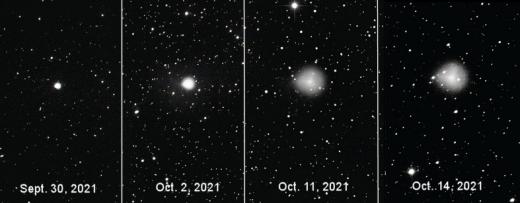
"Initially it looked like a bright compact object," says Herman. "Now the expanding cloud is 1.3 arcminutes wide (bigger than Jupiter) and sufficiently transparent for background stars to shine through."
When this object was discovered in 1927, astronomers thought they had found a fairly run-of-the-mill comet, unusual mainly because it was trapped in a nearly circular orbit between Jupiter and Saturn. 29P quickly proved them wrong as it began to erupt over and over again. Modern observations show that outbursts are happening as often as 20 times a year.
"The current outburst, which began on Sept. 25th, appears to be the most energetic of the past 40 years," says Dr. Richard Miles of the British Astronomical Association (BAA). "Within a span of only 56 hours, four eruptions took place in quick succession, creating a 'superoutburst.'"
Miles has developed a theory to explain what's happening. The "comet," he believes, is festooned with ice volcanoes. There is no lava. Instead, the volcanoes are powered by a mixture of liquid hydrocarbons (e.g., CH4, C2H4, C2H6 and C3H8) akin to those found in the lakes and streams of Saturn's moon Titan. In Miles's model, the cryomagma contains a sprinkling of dust and it is suffused with dissolved gases N2 and CO, all trapped beneath a surface which, in some places, has the consistency of wax. These bottled-up volatiles love to explode when a fissure is opened.
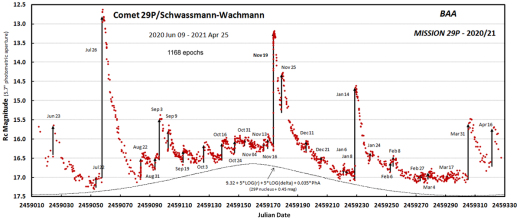
Above: A time series of previous outbursts from June 2020 - April 2021. These are all small compared to the current superoutburst. Source: Mission 29P.
In a seminal paper published 5 years ago, Miles studied more than a decade's worth of eruptions, and he found some patterns. The data suggest that 29P rotates every 57.7 days. The most active vents are concentrated on one side of the ice-ball in a range of longitudes less than 150 degrees wide. At least 6 discrete sources have been identified.
While most outbursts fade within a week or so, this superoutburst is still visible. The rat-a-tat-tat eruption in September boosted the comet's brightness 250-fold, and it hasn't declined much since then. With an integrated magnitude between +10 and +11, the expanding cloud is well within reach of backyard telescopes.
"Comet 29P can be seen with an 8 inch 'scope," says Herman. "In smaller instruments it will appear to be a bright dot. To resolve the cloud and photograph individual stars shining through it, I used the big half-meter iTelescope T11."
Ready see something weird? 29P is located in the constellation Auriga, easy to find high in the sky at midnight. Visit Sky&Telescope for observing tips. Also, for the latest news check out the BAA's MISSION 29P website.
Realtime Space Weather Photo Gallery
Free: Spaceweather.com Newsletter
STERLING SILVER OPAL PENDANT: It's our most beautiful space pendant ever: The Sterling Silver Opal. The students of Earth to Sky Calculus just launched one to the stratosphere onboard a cosmic ray research balloon. Here it is floating 103,018 ft above Earth's surface on Sept. 5th:
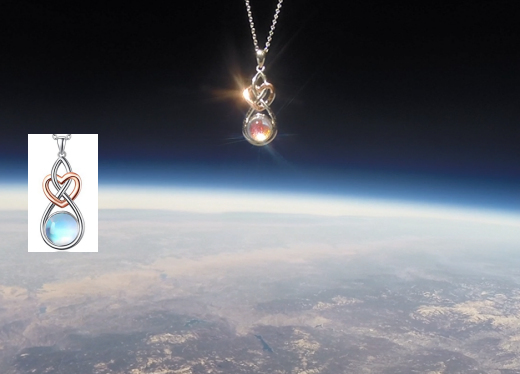
You can have it for $179.95. Wrapped in a sterling silver Celtic love knot, the opal is suspended from a matching 18-inch chain. Each pendant comes with a greeting card showing the opal in flight, telling the story of its trip to the edge of space and back again.
Opals are cousins of moonstones; in fact they look the same in low light. But when bright sunlight strikes an opal, something special happens. A spray of color emerges from the stone. This happened while the stone was in the stratosphere (see above) and it remains capable of this beautiful trick back on Earth.
Far Out Gifts: Earth to Sky Store
All sales support hands-on STEM education
Realtime Aurora Photo Gallery
Free: Spaceweather.com Newsletter
Every night, a network of
NASA all-sky cameras scans the skies above the United States for meteoritic fireballs. Automated software maintained by NASA's Meteoroid Environment Office calculates their orbits, velocity, penetration depth in Earth's atmosphere and many other characteristics. Daily results are presented here on Spaceweather.com.
On Oct 14, 2021, the network reported 21 fireballs.
(16 sporadics, 2 Orionids, 2 epsilon Geminids, 1 southern Taurid)
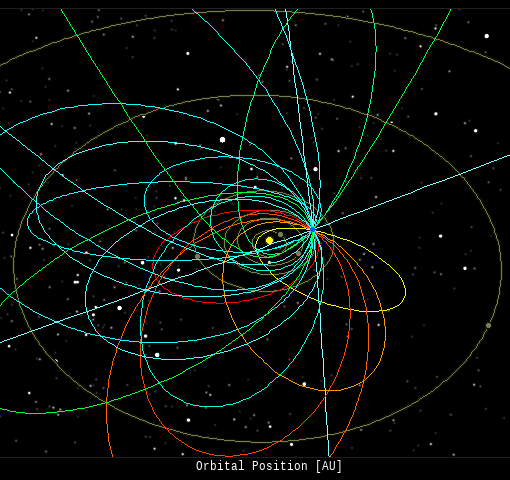
In this diagram of the inner solar system, all of the fireball orbits intersect at a single point--Earth. The orbits are color-coded by velocity, from slow (red) to fast (blue). [Larger image] [movies]
Potentially Hazardous Asteroids (
PHAs) are space rocks larger than approximately 100m that can come closer to Earth than 0.05 AU. None of the known PHAs is on a collision course with our planet, although astronomers are finding
new ones all the time.
On October 15, 2021 there were 2222 potentially hazardous asteroids.
 |
Recent & Upcoming Earth-asteroid encounters: | Asteroid | Date(UT) | Miss Distance | Velocity (km/s) | Diameter (m) |
| 2021 TT1 | 2021-Oct-10 | 1 LD | 17.1 | 20 |
| 2021 TT10 | 2021-Oct-10 | 1.7 LD | 14.6 | 73 |
| 2021 RF5 | 2021-Oct-10 | 19.9 LD | 8.8 | 48 |
| 2021 TE8 | 2021-Oct-10 | 6.5 LD | 11.1 | 19 |
| 2021 TO3 | 2021-Oct-10 | 13 LD | 9.7 | 19 |
| 2021 TQ1 | 2021-Oct-10 | 3.1 LD | 5.4 | 8 |
| 2021 TK11 | 2021-Oct-11 | 0.4 LD | 10.3 | 7 |
| 2021 TT13 | 2021-Oct-11 | 0.1 LD | 13.5 | 4 |
| 2021 TH15 | 2021-Oct-11 | 0.8 LD | 12.5 | 6 |
| 2021 TQ6 | 2021-Oct-11 | 9.6 LD | 5.3 | 28 |
| 2021 QF5 | 2021-Oct-11 | 15.4 LD | 7.1 | 62 |
| 2019 SE5 | 2021-Oct-11 | 16.3 LD | 6.6 | 16 |
| 2021 TY2 | 2021-Oct-11 | 10.2 LD | 5.2 | 15 |
| 2021 TC13 | 2021-Oct-11 | 11.7 LD | 9.5 | 23 |
| 2021 SF1 | 2021-Oct-12 | 6.2 LD | 3.4 | 13 |
| 2021 TN1 | 2021-Oct-12 | 7.5 LD | 3.6 | 19 |
| 2021 TE13 | 2021-Oct-12 | 0.1 LD | 10.9 | 5 |
| 2021 TS10 | 2021-Oct-12 | 17 LD | 8.4 | 29 |
| 2021 TN9 | 2021-Oct-12 | 10.4 LD | 8.6 | 15 |
| 2021 TN14 | 2021-Oct-13 | 1.6 LD | 10.7 | 7 |
| 2021 TX10 | 2021-Oct-13 | 2.5 LD | 8.6 | 9 |
| 2021 TP8 | 2021-Oct-14 | 4.4 LD | 12.3 | 10 |
| 2021 TM14 | 2021-Oct-14 | 0.4 LD | 8.5 | 8 |
| 2021 TL14 | 2021-Oct-14 | 1.3 LD | 6 | 15 |
| 2021 TS3 | 2021-Oct-14 | 10.9 LD | 4.2 | 13 |
| 2021 TC1 | 2021-Oct-14 | 14.6 LD | 6.6 | 31 |
| 2021 SM1 | 2021-Oct-14 | 6.9 LD | 7.2 | 27 |
| 2021 TT4 | 2021-Oct-14 | 5.1 LD | 3.1 | 9 |
| 2021 TN6 | 2021-Oct-14 | 10 LD | 19.8 | 35 |
| 2021 SM3 | 2021-Oct-15 | 13 LD | 15.8 | 96 |
| 2021 TV10 | 2021-Oct-15 | 1.9 LD | 11.6 | 10 |
| 2021 TD13 | 2021-Oct-15 | 7 LD | 10 | 13 |
| 2017 TH1 | 2021-Oct-15 | 15 LD | 8.8 | 31 |
| 2021 TK10 | 2021-Oct-15 | 5.9 LD | 9.8 | 12 |
| 2021 TY14 | 2021-Oct-15 | 2 LD | 8.8 | 14 |
| 2021 TJ15 | 2021-Oct-16 | 1 LD | 12.3 | 8 |
| 2021 TF13 | 2021-Oct-16 | 7.5 LD | 18 | 19 |
| 2021 TJ12 | 2021-Oct-17 | 5.5 LD | 9.6 | 22 |
| 2021 TH13 | 2021-Oct-17 | 1.7 LD | 8.6 | 8 |
| 2021 TG14 | 2021-Oct-18 | 0.7 LD | 11.4 | 7 |
| 2021 TO14 | 2021-Oct-18 | 6.4 LD | 15.8 | 36 |
| 2020 TH6 | 2021-Oct-19 | 7.3 LD | 5.9 | 6 |
| 2021 TX2 | 2021-Oct-19 | 9 LD | 10.7 | 33 |
| 2021 TX14 | 2021-Oct-19 | 1.3 LD | 10.5 | 17 |
| 1996 VB3 | 2021-Oct-20 | 8.8 LD | 15.3 | 135 |
| 2021 TV3 | 2021-Oct-21 | 13.3 LD | 12.7 | 47 |
| 2021 TE4 | 2021-Oct-21 | 8.3 LD | 6 | 15 |
| 2021 SG2 | 2021-Oct-21 | 15.9 LD | 5.9 | 25 |
| 2021 RE10 | 2021-Oct-21 | 15.5 LD | 5.1 | 56 |
| 2021 TE1 | 2021-Oct-23 | 9.5 LD | 12.4 | 47 |
| 2017 SJ20 | 2021-Oct-25 | 18.7 LD | 15.7 | 120 |
| 2019 UW6 | 2021-Oct-26 | 8 LD | 11.1 | 17 |
| 2009 WY7 | 2021-Nov-02 | 19.2 LD | 14.7 | 54 |
| 2021 TJ14 | 2021-Nov-02 | 19 LD | 9.6 | 40 |
| 2017 TS3 | 2021-Nov-02 | 13.9 LD | 9.9 | 131 |
| 2005 VL1 | 2021-Nov-04 | 17 LD | 5.2 | 18 |
| 2020 KA | 2021-Nov-06 | 14.9 LD | 4.8 | 11 |
| 2021 SP3 | 2021-Nov-08 | 15.6 LD | 9.3 | 70 |
| 2019 XS | 2021-Nov-09 | 1.5 LD | 10.7 | 65 |
| 2017 WG14 | 2021-Nov-10 | 18.6 LD | 11.6 | 45 |
| 2007 VD138 | 2021-Nov-12 | 16 LD | 7.7 | 44 |
| 2004 UE | 2021-Nov-13 | 11.1 LD | 13.2 | 224 |
| 2016 VR | 2021-Nov-15 | 8 LD | 8.7 | 20 |
| 2010 VK139 | 2021-Nov-15 | 6.4 LD | 13.9 | 65 |
| 2019 VL5 | 2021-Nov-15 | 8.6 LD | 8 | 23 |
| 2016 JG12 | 2021-Nov-20 | 14.4 LD | 7.5 | 112 |
| 2021 KH2 | 2021-Nov-21 | 19.3 LD | 6.5 | 31 |
| 3361 | 2021-Nov-21 | 15.1 LD | 8.1 | 511 |
| 2014 WF201 | 2021-Nov-24 | 13.2 LD | 5.5 | 27 |
| 2009 WB105 | 2021-Nov-25 | 15.1 LD | 18.9 | 71 |
| 2019 BB5 | 2021-Nov-25 | 18.8 LD | 8.3 | 16 |
| 1994 WR12 | 2021-Nov-29 | 16.1 LD | 8.8 | 123 |
| 4660 | 2021-Dec-11 | 10.3 LD | 6.6 | 774 |
| 2019 XQ1 | 2021-Dec-13 | 14.1 LD | 9.1 | 30 |
Notes: LD means "Lunar Distance." 1 LD = 384,401 km, the distance between Earth and the Moon. 1 LD also equals 0.00256 AU. MAG is the visual magnitude of the asteroid on the date of closest approach. | | Cosmic Rays in the Atmosphere |
SPACE WEATHER BALLOON DATA: Almost once a week, Spaceweather.com and the students of Earth to Sky Calculus fly space weather balloons to the stratosphere over California. These balloons are equipped with sensors that detect secondary cosmic rays, a form of radiation from space that can penetrate all the way down to Earth's surface. Our monitoring program has been underway without interruption for 6 years, resulting in a unique dataset of in situ atmospheric measurements.
Latest results: Our most recent flight on June 25, 2021, confirms a trend of decreasing cosmic radiation:
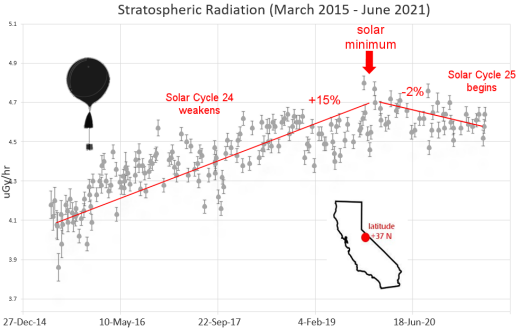
Cosmic ray dose rates peaked in late 2019, and have been slowly declining ever since. This makes perfect sense. Solar Minimum was in late 2019. During Solar Minimum the sun's magnetic field weakens, allowing more cosmic rays into the solar system. We expect dose rate to be highest at that time.
Now that Solar Minimum has passed, the sun is waking up again. Solar magnetic fields are strengthening, providing a stiffer barrier to cosmic rays trying to enter the solar system. The decline of cosmic radiation above California is a sign that new Solar Cycle 25 is gaining strength.
.Who cares? Cosmic rays are a surprisingly "down to Earth" form of space weather. They can seed clouds, trigger lightning, and penetrate commercial airplanes. According to a study from the Harvard T.H. Chan school of public health, crews of aircraft have higher rates of cancer than the general population. The researchers listed cosmic rays, irregular sleep habits, and chemical contaminants as leading risk factors. Somewhat more controversial studies (#1, #2, #3, #4) llink cosmic rays with cardiac arrhythmias and sudden cardiac death.
En route to the stratosphere, our sensors also pass through aviation altitudes:
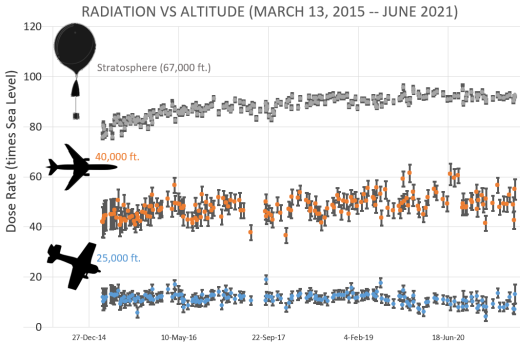
In this plot, dose rates are expessed as multiples of sea level. For instance, we see that boarding a plane that flies at 25,000 feet exposes passengers to dose rates ~10x higher than sea level. At 40,000 feet, the multiplier is closer to 50x. The higher you fly, the more radiation you will absorb.
Technical notes:
The radiation sensors onboard our helium balloons detect X-rays and gamma-rays in the energy range 10 keV to 20 MeV. These energies span the range of medical X-ray machines and airport security scanners.
Data points in the first graph ("Stratospheric Radiation") correspond to the peak of the Regener-Pfotzer maximum, which lies about 67,000 feet above central California. When cosmic rays crash into Earth's atmosphere, they produce a spray of secondary particles that is most intense at the entrance to the stratosphere. Physicists Eric Regener and Georg Pfotzer discovered the maximum using balloons in the 1930s and it is what we are measuring today.
| | The official U.S. government space weather bureau |
| | The first place to look for information about sundogs, pillars, rainbows and related phenomena. |
| | Researchers call it a "Hubble for the sun." SDO is the most advanced solar observatory ever. |
| | 3D views of the sun from NASA's Solar and Terrestrial Relations Observatory |
| | Realtime and archival images of the Sun from SOHO. |
| | information about sunspots based on the latest NOAA/USAF Active Region Summary |
| | from the NOAA Space Environment Center |
| | fun to read, but should be taken with a grain of salt! Forecasts looking ahead more than a few days are often wrong. |
| | from the NOAA Space Environment Center |
| | the underlying science of space weather |
 | Going above and beyond to provide the best homes listings in the Comox real estate market to keep you up to date and informed |
 | One of the most popular casino games is the Book Of Dead Slot based on ancient Egyptian text, you can find all the casinos with spins at bookofdeadslotsites.com. |
 | When looking for casinos to play online when the weather is bad, you can try luotettavat nettikasinot for Finnish games. If you are not from Finland you can try the Swedish page Svenska casino online to find suitable games, check out svenskacasinoonline.net. Always check your local laws before playing with real money. |
 | Finns rank fourth among the world’s biggest gamblers. More on Finnish online casinos you can find at Nettikasino site. |
 | To find reviews of new online casino sites in the UK try The Casino DB where there are hundreds of online casino reviews complete with bonuses and ratings. Alternatively, Online-Casinos.xyz is another massive directory of online casinos listing sites for the UK and Worldwide. Casinos that offer Rupees for bonuses are very generous to Indian players. Find the best online casinos in India at AllCasinos.in Looking for a new online casino? Try Casimpo the new site dedicated to making online casino simple, or check out the new Avenger Slots Casino and Ace Online Casino with over 500 online slots and casino games. |
| | These links help Spaceweather.com stay online. Thank you to our supporters! |
| | | | | | |

